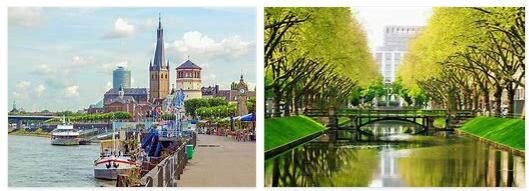
Düsseldorf, capital of North Rhine-Westphalia with (2019) 621 900 residents, located on the Lower Rhine.
The university city is a center of fashion and art with many museums and galleries, opera houses and theaters. Benefiting from the good traffic situation (major airport, etc.), Düsseldorf has developed into an important trade fair, trade and congress city.
The Königsallee, or »Kö« for short, and the old town to the north with its many restaurants are well known.
Attractions
The Königsallee and the old town to the north with its many restaurants have become Düsseldorf’s landmarks. The old town, which was badly damaged in the Second World War, was partially rebuilt. Worth mentioning are: Parish Church of St. Andrew (former Jesuit church, 1622–29); Catholic parish church Sankt Lambertus (former collegiate church, 1288–1394); Old Town Hall (1570–73), in front of it the equestrian statue of Elector Johann Wilhelm II. (»Jan Wellem«, 1703–11 by G. de Grupello); at the Hofgarten Schloss Jägerhof (1752–63; today Goethe Museum) by Johann Joseph Couven; Ratinger Tor, two opposing guard houses (1811–15) by Adolph Anton von Vagedes.
Modern architecture sets in with the construction of the Tietz department store (1907-09) by J. M. Olbrich, followed by the former administration building of Mannesmann AG (1911/12) by P. Behrens, next to which is the Mannesmann high-rise (1956-58) by P. Schneider from Esleben. Other notable buildings are: Wilhelm-Marx-Haus (1922–24) by Wilhelm Kreis (1982–84 expanded by H. Hentrich, Hubert Petschnigg and partners); Administration building of the Stumm Group (1922–24) by P. Bonatz; Hotel Breidenbacher Hof (built 1808–12, remodeled in 1927 by Emil Fahrenkamp; rebuilt by the same after the Second World War, modified; New building 2005–08 by the architects Hentrich-Petschnigg & Partner [HPP]). The Ehrenhofanlage, an ensemble of event and exhibition buildings designed by Kreis for the trade exhibition “Gesolei” (health care, social welfare and physical exercise) in 1925/26 with the Museum Kunstpalast (originally changed in 1902, 1926; extensive renovation by Oswald Matthias Ungers 1998–2001), NRW-Forum Kultur und Wirtschaft (formerly the State Museum for People and Economy) and today’s Tonhalle (former planetarium, conversion to a concert hall 1975-78 by Hentrich-Petschnigg & Partner), with buildings by Behrens, B. Taut and others. added.
Buildings from the 1950s to 1970s are also characteristic of the cityscape: Thyssen high-rise (1957–60, “Dreischeibenhaus”) by Hentrich and Petschnigg, a steel sculpture by E. Chillida was placed on the courtyard garden side in 1971; Playhouse by Bernhard Pfau (1965–69). The new building of the state insurance institute was built by H. Deilmann in 1974–76. Hentrich-Petschnigg & Partner and Takenaka Komuten built the German-Japanese Center (1977–79). The office Dissing + Weitling (Copenhagen) carried out the new building for the art collection of North Rhine-Westphalia (today K20 with 20th century art) from 1979–86. The former Ständehaus (19th century) was converted into a museum (opened in 2002) for contemporary art (K21).
Representative passages “Kö-Galerie” and “Kö-Karree” as well as the “Schadow-Arkaden” increased the attractiveness of the pedestrian zone. The Rheinturm (1981/82, architect: Deilmann), the tallest building in the city with its height of 234.2 m, and the new state parliament (1988, by the architects Eller, Maier, Moser, Walter & Partner) were built in Rheinpark Bilk. as well as the new building of the WDR regional studio (1992) nearby. With the completion of the Rheinuferpromenade (1995), the urban reorientation was underlined, which “rediscovered” the Rhine and its expansive banks and includes it in the town planning to a special degree. Part of the main port on the outskirts of the city was built with the participation of well-known architects (including F. O. Gehry, S. Holl, D. Chipperfield) redesigned (»Medienhafen«), while the old trading port (1896) was preserved in its entirety as a technical monument. In this context, the city also received a new landmark, the media center “Neuer Zollhof” by Gehry (1997–99). Over 700 companies have now settled in the “Medienhafen”.
Districts: In the Benrath district there is the pleasure palace (palace museum, museum for natural history and museum for European garden art) of Elector Karl Theodor von der Pfalz, built by N. de Pigage in the French rococo style in 1755–69, exquisite interior design. In the Gerresheim district is the former women’s collegiate church (founded in 870), consecrated in 1236, built in a Romanesque-Gothic transition style, with a 10th century crucifix. In the Kaiserswerth districtstands the former Hohenstaufen imperial palace (building inscription 1184), of which the main front of the palace has been preserved. The Suitbertkirche of the former Benedictine monastery (founded around 700) is a pillar basilica (consecrated in 1078; 2nd construction period in the 12th / 13th century), the Suitbertus shrine (13th century) belongs to the church treasury. Buildings of the former monastery immunity have been preserved on Suitbertus-Stiftsplatz; The old customs house from 1635 is on Kaiserswerth-Markt. In the neighboring Kalkum district there is the moated castle of the same name, a four-wing complex in the classicist style.